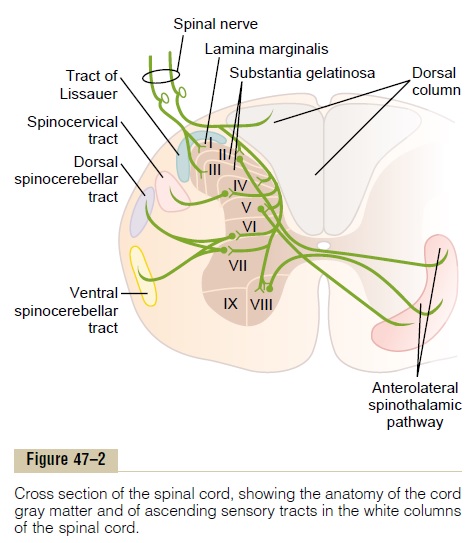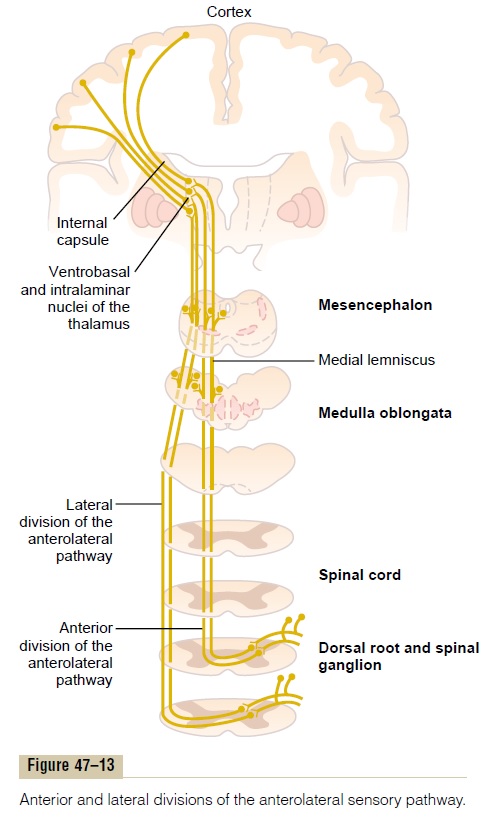Chapter: Medical Physiology: Somatic Sensations: I. General Organization, the Tactile and Position Senses
Transmission of Less Critical Sensory Signals in the Anterolateral Pathway
Transmission of Less Critical Sensory Signals in the Anterolateral Pathway
The anterolateral pathway for transmitting sensory signals up the spinal cord and into the brain, in contrast to the dorsal column pathway, transmits sensory signals that do not require highly discrete localization of the signal source and do not require discrimination of fine gradations of intensity. These types of signals include pain, heat, cold, crude tactile, tickle, itch, and sexual sensations.
Anatomy of the Anterolateral Pathway
The spinal cord anterolateral fibers originate mainly in dorsal horn laminae I, IV, V, and VI (see Figure 47–2). These laminae are where many of the dorsal root sensory nerve fibers terminate after entering the cord.

As shown in Figure 47–13, the anterolateral fibers cross immediately in the anterior commissure of the cord to the opposite anterior and lateral white columns, where they turn upward toward the brain by way of the anterior spinothalamic and lateral spinothalamic tracts.

The upper terminus of the two spinothalamic tracts is mainly twofold: (1) throughout the reticular nuclei of thebrain stem and (2) in two different nuclear complexesof the thalamus, the ventrobasal complex and the intralaminar nuclei. In general, the tactile signals aretransmitted mainly into the ventrobasal complex, ter-minating in some of the same thalamic nuclei where the dorsal column tactile signals terminate. From here, the signals are transmitted to the somatosensory cortex along with the signals from the dorsal columns.
Conversely, only a small fraction of the pain signals project directly to the ventrobasal complex of the thal-amus. Instead, most pain signals terminate in the retic-ular nuclei of the brain stem and from there are relayed to the intralaminar nuclei of the thalamus where the pain signals are further processed.
Characteristics of Transmission in the Anterolateral Pathway.
In general, the same principles apply to transmission in the anterolateral pathway as in the dorsal column–medial lemniscal system, except for the fol-lowing differences: (1) the velocities of transmission are only one third to one half those in the dorsal column–medial lemniscal system, ranging between 8 and 40 m/sec; (2) the degree of spatial localization of signals is poor; (3) the gradations of intensities are also far less accurate, most of the sensations being recog-nized in 10 to 20 gradations of strength, rather than as many as 100 gradations for the dorsal column system;
and (4) the ability to transmit rapidly changing or rapidly repetitive signals is poor.
Thus, it is evident that the anterolateral system is a cruder type of transmission system than the dorsal column–medial lemniscal system. Even so, certain modalities of sensation are transmitted only in this system and not at all in the dorsal column–medial lemniscal system. They are pain, temperature, tickle, itch, and sexual sensations, in addition to crude touch and pressure.
Related Topics